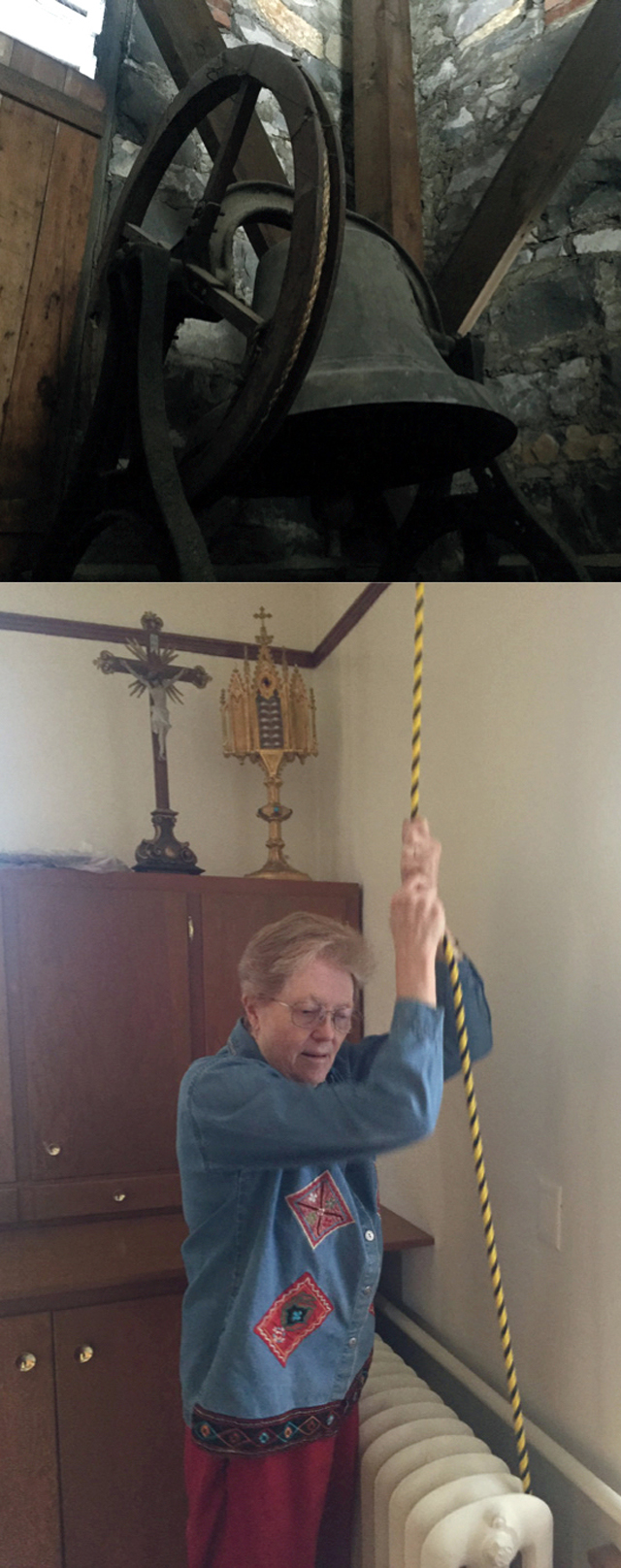| The
bells of St. Gertrude's
For bells are the voice of the church; They have tones that touch and search the hearts of young and old. ~ Henry Wadsworth Longfellow With the exception of Good Friday and Holy Saturday (the two days before Easter Sunday), the bells of St. Gertrude’s ring out over the Camas Prairie everyday of the year, as they have since the early twentieth century. While the chapel is on the National Register of Historic Places, the sound of the bells proves that this sacred building is still in use for the purpose it was intended when it was dedicated in 1924. “For me, it’s the call,” says Sister Agnes Reichlin. “St. Benedict has this in the Rule: The bells are that call of God to worship and community prayer.” Four bronze bells of varying sizes are rung by sisters throughout the day for prayer and Mass. The largest bell is named Sacred Heart and was donated by John and Gertrude Uhlenkott in 1908. The second largest bell is St. Joseph and was donated by Joseph and Amalia Uhlenkott in 1912. The other two bells, St. Michael (third largest), and St. Gabriel (smallest), were given by Mr. and Mrs. Frank Rad to the nearby St. Michael’s Monastery. When the monks withdrew from Cottonwood in 1925 they donated these two bells to St. Gertrude’s. The St. Gabriel bell was blessed for protection from hail and St. Michael for protection from lightning. All four bells are mounted in the south tower. They are rung from ropes that descend several floors to the sacristy. “The bells have many messages,” says Sister Meg Sass. “It is hard to describe the feelings they evoke. I hear them but I also feel them moving the molecules of my body. At times they are solemn. At other times I hear the joyousness of heaven. They lift me up and out of ordinary time and space. Somehow they say there is a deeper world beyond this world. Come spend some time here.” The two smallest bells are rung daily, calling sisters and guests to the chapel for prayer from morning to evening. All four bells are rung for daily Mass, to announce prayer on solemn feasts, during a graveside burial of a sister, and during Mass on solemn holy days. The two largest bells are tolled alternately at the time of death of a sister, when the hearse arrives at the Monastery with the body of sister, and during the funeral procession to the cemetery. The Sacred Heart Bell is tolled while a sister is under the resurrection pall during her perpetual profession ceremony. Ringing the bells requires a special touch as they are easy to tip over. Sister Meg remembers how postulants and novices used to be assigned bell-ringing a week at a time. “Ringing the bells was always a nerve-wracking week…the other sisters were listening for whether we were on time, and ringing too harshly or too timidly.” The commissioning of a bell for liturgical purposes is an elaborate ceremony called a “baptism” where the bell is covered in white, decorated with flowers, anointed, incensed, and given a name. The ceremony is accompanied by psalms, prayers, and liturgical music. “The Benedictine bell can be heard not only within the monastery but by the world outside, for a good reason,” wrote monastic Jim Miller. “Part of its purpose is to call the attention of the world to what is happening within. ‘Listen,’ says the bell.” Unlike the sisters living at home at the Monastery of St. Gertrude, much of the modern world lives outside the call of bells, though Sister Meg quickly points out that many aspects of our lives can serve in similar ways. “Even a school bell or siren can be your reminder to take a moment to pray. The timer that reminds you to take medications can also be a call to personal prayer. There are many prayer apps that can alert you throughout the day to connect with God…it is all about the grace and spirituality of the present moment, to remember God is walking with you, where you are reminded to squeeze the hand once in awhile.” 
Sister Placida Wemhoff rings the bell calling all to prayer. 
The Monastery of St. Gertrude indicating where the bell tower is located. |
|